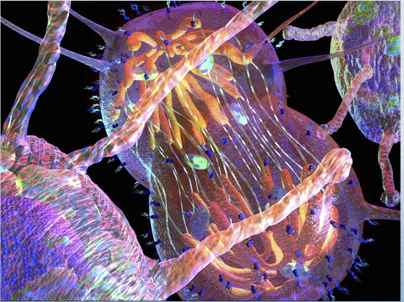Unexpected discovery of the ways cells move could boost understanding of complex diseases
A new discovery about how cells move inside the body may provide scientists with crucial information about disease mechanisms such as the spread of cancer or the constriction of airways caused by asthma. Led by researchers at Harvard School of Public Health (HSPH) and the Institute for Bioengineering of Catalonia (IBEC), investigators found that epithelial cells - the type that form a barrier between the inside and the outside of the body, such as skin cells - move in a group, propelled by forces both from within and from nearby cells - to fill any unfilled spaces they encounter.
The study appears June 23, 2013 in an advance online edition of Nature Materials.
“We were trying to understand the basic relationship between collective cellular motions and collective cellular forces, as might occur during cancer cell invasion, for example. But in doing so we stumbled onto a phenomenon that was totally unexpected,” said senior author Jeffrey Fredberg, professor of bioengineering and physiology in the HSPH Department of Environmental Health and co-senior investigator of HSPH’s Molecular and Integrative Cellular Dynamics lab.
Biologists, engineers, and physicists from HSPH and IBEC worked together to shed light on collective cellular motion because it plays a key role in functions such as wound healing, organ development, and tumor growth. Using a technique called monolayer stress microscopy - which they invented themselves - they measured the forces affecting a single layer of moving epithelial cells. They examined the cells’ velocity and direction as well as traction- how some cells either pull or push themselves and thus force collective movement.
As they expected, the researchers found that when an obstacle was placed in the path of an advancing cell layer - in this case, a gel that provided no traction - the cells moved around it, tightly hugging the sides of the gel as they passed. However, the researchers also found something surprising - that the cells, in addition to moving forward, continued to pull themselves collectively back toward the gel, as if yearning to fill the unfilled space. The researchers dubbed this movement “kenotaxis,” from the Greek words “keno” (vacuum) and “taxis” (arrangement), because it seemed the cells were attempting to fill a vacuum.
This new finding could help researchers better understand cell behavior- and evaluate potential drugs to influence that behavior- in a variety of complex diseases, such as cancer, asthma, cardiovascular disease, developmental abnormalities, and glaucoma. The finding could also help with tissue engineering and regenerative medicine, both of which rely on cell migration.
In carcinomas, for instance- which represent 90% of all cancers and involve epithelial cells- the new information on cell movement could improve understanding of how cancer cells migrate through the body. Asthma research could also get a boost, because scientists think migration of damaged epithelial cells in the lungs are involved in the airway narrowing caused by the disease.
 “Kenotaxis is a property of the cellular collective, not the individual cell,” said Jae Hun Kim, the study’s first author. “It was amazing to us that the cellular collective can organize to pull itself systematically in one direction while moving systematically in an altogether different direction.”
“Kenotaxis is a property of the cellular collective, not the individual cell,” said Jae Hun Kim, the study’s first author. “It was amazing to us that the cellular collective can organize to pull itself systematically in one direction while moving systematically in an altogether different direction.”
###
Other HSPH authors included James Butler, senior lecturer on physiology in the Department of Environmental Health and co-senior investigator of the lab; and researchers Dhananjay Tambe, Enhua Zhou, Chan Young Park, Monirosadat Sadati, Jin-Ah Park, Bomi Gweon, and Emil Millet.
Support for the study came from the Spanish Ministry for Science and Innovation (BFU2012-38146 and FPU fellowship XS), the Swiss National Science Foundation (PBEZP2-140047), the National Research Foundation of Korea (2012R1A6A3A03040450), the European Research Council (Grant Agreement 242993), Parker B. Francis (Fellowship RK), American Heart Association (13SDG14320004), and the National Institutes of Health (R01HL102373, R01HL107561).
“Propulsion and navigation within the advancing monolayer sheet,” Jae Hun Kim, Xavier Serra-Picamal, Dhananjay T. Tambe, Enhua H. Zhou, Chan Young Park, Monirosadat Sadati, Jin-Ah Park, Ramaswamy Krishnan, Bomi Gweon, Emil Millet, James P. Butler, Xavier Trepat, Jeffrey J. Fredberg, Nature Materials, online, June 23, 2013
Visit the HSPH website for the latest news, press releases and multimedia offerings.
Harvard School of Public Health brings together dedicated experts from many disciplines to educate new generations of global health leaders and produce powerful ideas that improve the lives and health of people everywhere. As a community of leading scientists, educators, and students, we work together to take innovative ideas from the laboratory to people’s lives- not only making scientific breakthroughs, but also working to change individual behaviors, public policies, and health care practices. Each year, more than 400 faculty members at HSPH teach 1,000-plus full-time students from around the world and train thousands more through online and executive education courses. Founded in 1913 as the Harvard-MIT School of Health Officers, the School is recognized as America’s first professional training program in public health.
###
Marge Dwyer
mhdwyer@hsph.harvard.edu
617-432-8416
Harvard School of Public Health